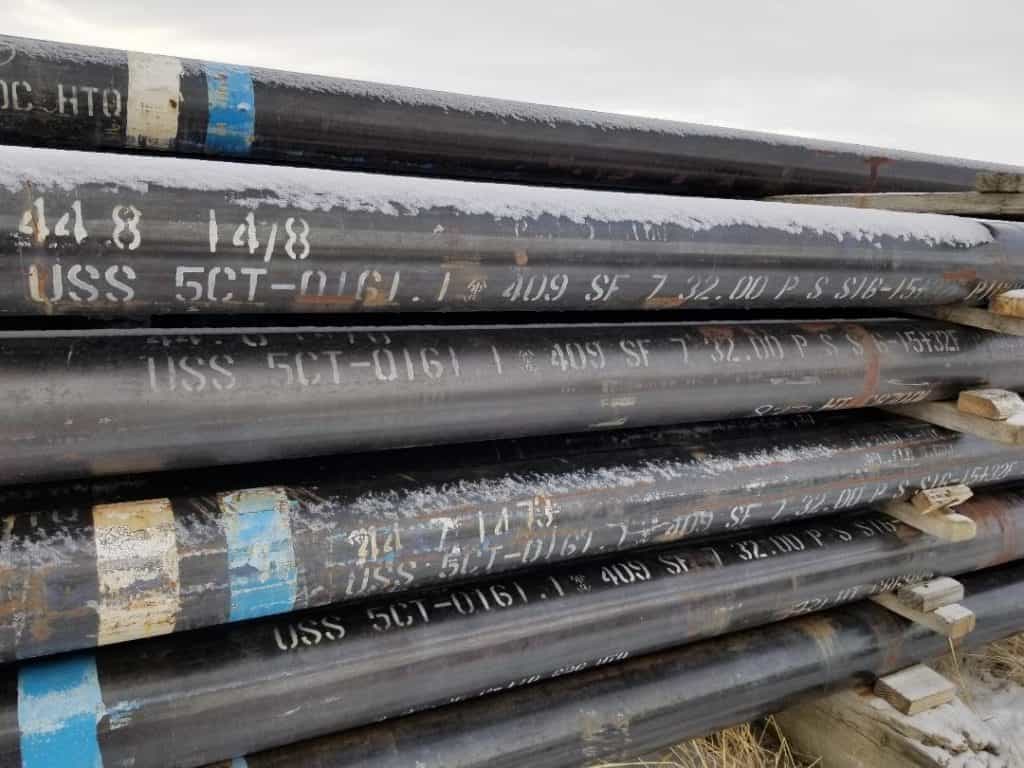White Band - Yellow Band - Used Pipe
Looking for white band, yellow band, blue band, green band or red band used pipe?
White, Yellow, Blue, Green, and Red Band Pipe Standards
White Band – 0% to 12.5% wall loss
Yellow Band – 12.5% to 15% wall loss
Blue Band – 16% to 30% wall loss
Green Band – 31% to 50% wall loss
Red Band / Structural – Above 50% wall loss

WHAT DO BANDS COLORS ON PIPE MEAN?
Drill pipe is evaluated and checked after every use. With the increasing price of new pipe, the demand for used drill pipe keeps increasing. Be sure to contact Baker Tubulars today to get a quote and secure your pricing!

New & Used
Casing and Tubing
Oil and gas production is a highly complex process. When a wellbore is dug, it goes through 3 main phases: drilling with drill pipe, lining with casing, and production with tubing.
Casing and tubing are the key components of the well construction. All bore wells dug for production and extraction of oil or gas production need to be made from material that is strong and have a high degree of functionality.
Casing
Casing pipe plays an important role in the oil drilling process. It is an important component of the oil well and offers structural stability. Casing is required for providing structure and strength to the walls of the well hole preventing the walls from collapsing. It ensures there is no seepage of oil or natural gas when they are being drilled and brought to the surface.
The casing is required for maintaining the bore well stability, preventing contamination. It also isolates water from the oil and gas and controls the well pressures during the drilling, production and workover operations.
Tubing
Tubing is pipe through which the produced oil and gas are brought to the field surface facilities for processing. Similar to the casing, tubing also needs to be strong enough to resist loads and deformations arising from production and workovers. The size and dimensions of the tubing are dependent on the support it needs to provide as per the rate of production of oil and gas

Types of Casing
Installation of casing requires careful planning. Several factors like the subsurface characteristics, the well diameter, and the pressure and temperature inside the well need to be carefully accounted for while planning the installation of the various casing strings. There are five different types of casing pipe:
Conductor Casing
The conductor casing is the first string that runs in the well up to the depth of 40 to 300 feet. If the offshore environment has soft formation areas, the conductor pipe is hammered down with the help of a large pipe hammer. In the hard rocky area, hammering the casing is not doable hence a larger hole is drilled to landing depth before installing and cementing the conductor casing. Installation of the conductor casing helps prevent the caving in of the top of the well. It helps the circulation of the drilling fluid from the bottom of the well to the top.
Surface Casing – Structural
The second type of casing to be installed after the conductor casing is the surface casing. The length can range from a few feet to 2,000 feet long. Though longer in height, it is smaller in diameter as compared to the conductor casing. The surface casing is fitted inside the top of the conductor casing. The key purpose of surface casing is to prevent the contamination of the fresh water deposits near the surface of the well from the leaking hydrocarbons or salt water seeping underground. It also acts as a tube for drilling mud that returns to the surface. It protects the drill hole from any damage during the drilling process. Like conductor casing, the surface casing is also cemented into place.
Intermediate Casing
Intermediate casing is the longest casing in the bore well. The key purpose of intermediate casing is to reduce the hazards associated with the subsurface formations affecting the well. These formations include abnormal underground pressure zones, underground shale, and more. In most cases, even though there is no evidence showing any form of unusual underground formation, the intermediate casing is introduced as a safety measure to protect the well from any such formation.
Liner Strings
Liner strings are used as an alternative to the intermediate casing. They generally run from the bottom of another casing to the open well area. Unlike Intermediate casing, the liner strings are attached to the previous casing with hangers. They are not cemented in place like the other types of casings.
Production Casing
Production casing is the last casing to be installed. It reaches the deepest section of the well. It is popularly known as the ‘oil string’ or ‘long string’. It provides a channel from the top of the well to the bottom where the petroleum is produced. The size of the production casing is dependent on a number of factors like the size of the lifting equipment, the number of completions required, and the possibility of deepening the well in the future.
We supply White, Yellow, Blue, Green, and Red Band Pipe!
Baker Tubulars offers new and used casing and tubing in multiple sizes to fit your project requirements. We offer white band (wb), yellow band (yb), blue band (bb), green band (gb), and red band (rb) pipe. Whether you need oilfield pipe for drilling downhole, water wells, or structural pipe for many applications, such as building fences or corrals, contact us and we can provide you a quote for pipe delivered or picked up anywhere in the United States and Canada.
WB, YB, BB, GB, RB pipe for sale
Baker Tubulars supplies white band, yellow band, blue band, green band, and red band pipe to the United States and Canada.

